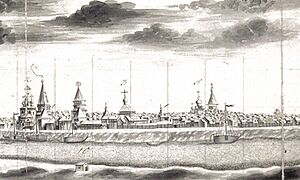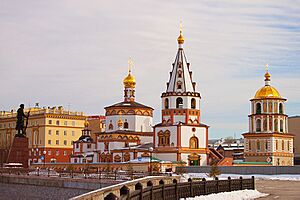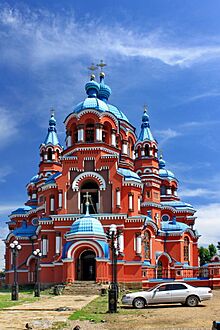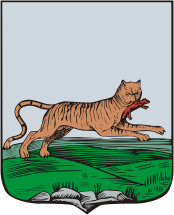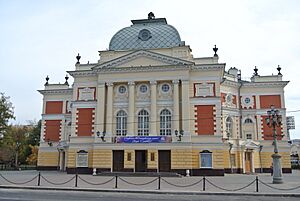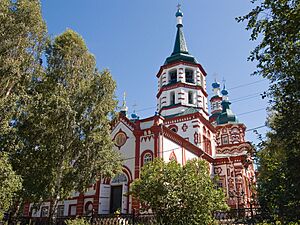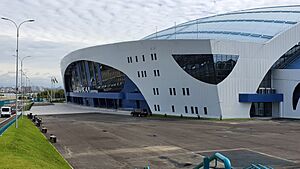Irkutsk facts for kids
Quick facts for kids Irkutsk (English)Иркутск (Russian) |
|
|---|---|
| - City - | |
 Clockwise, from the upper right corner: Clock Tower, Picture Gallery, Irkutsk panorama from the dam, Local Lore Museum, Khudozhestvenny Cinema, Kazan Church |
|
|
|
|
| City Day | First Saturday of June |
| Administrative status | |
| Country | Russia |
| Federal subject | Irkutsk Oblast |
| Administratively subordinated to | City of Irkutsk |
| Municipal status | |
| Urban okrug | Irkutsk Urban Okrug |
| Mayor | Ruslan Bolotov |
| Representative body | Duma of Irkutsk |
| Statistics | |
| Area | 277 km2 (107 sq mi) |
| Population (2010 Census, preliminary) |
587,891 inhabitants |
| - Rank in 2010 | 24th |
| Density | 2,122/km2 (5,496/sq mi) |
| Time zone | IRKT (UTC+09:00) |
| Founded | 1661 |
| Postal code(s) | 664xxx |
| Dialing code(s) | +7 3952 |
| Official website: https://irkutsk.ru/ | |
Irkutsk (/ɪərˈkutsk/ EER-kootsk; Russian: Иркутск, IPA: [ɪrˈkutsk]; Buryat and Mongolian: Эрхүү, Erhüü, [ɛrˈxuː]) is a large city and the main city of the Irkutsk Oblast region in Russia. In 2010, about 587,891 people lived there, making it one of the biggest cities in Siberia.
Irkutsk is located in the southern part of the Irkutsk region. It sits on the Angara River, which is a smaller river that flows into the Yenisei. The city is about 850 kilometers (530 miles) southeast of Krasnoyarsk and about 520 kilometers (320 miles) north of Ulaanbaatar, the capital of Mongolia. Important roads and railways, like the Trans-Siberian Highway and Trans-Siberian Railway, connect Irkutsk to other parts of Russia and Mongolia.
Many important Russians were sent to Irkutsk as a form of punishment after the Decembrist revolt in 1825. Because of this, the city became a center for learning and social life for many years. You can still see some old wooden houses with beautiful carvings today. When the railway arrived in Irkutsk, people started calling it "The Paris of Siberia." The city also saw big battles during the Russian Civil War from 1918 to 1920. Today, the historic center of Irkutsk is being considered as a World Heritage Site by UNESCO.
Contents
About the Name of Irkutsk
Irkutsk gets its name from the Irkut River. The name comes from a Buryat word meaning "spinning." This word was also used for local tribes like the Yrkhu and Irkit.
Before the Russian Revolution, people sometimes called Irkutsk "East Paris," "Siberian Petersburg," or "Siberian Athens." These nicknames show how important and beautiful the city was seen to be.
History of Irkutsk
In 1652, a man named Ivan Pokhabov built a winter camp near where Irkutsk is now. He did this for trading gold and collecting fur taxes from the local Buryats. In 1661, Yakov Pokhabov built a small fort, called an ostrog, nearby. This fort officially became a town in 1686.
The Irkutsk fort, built in 1661, quickly became more than just a defense point because of its good location. Historical records show that by 1671, families lived there, not just soldiers. A settlement grew around the fort, which became the start of the city. The fort itself was rebuilt twice, in 1669 and 1693, becoming larger each time.
The fort's location was key, as it was at a crossroads for trade and travel in Eastern Siberia. In 1682, it became the center of its own region, and in 1686, it officially became a city. By the early 1700s, Irkutsk had two parts: the "small town," which was the fort itself, and the "big city," which was the main settlement. The "small town" had wooden walls and important buildings like the governor's office and the Church of the Savior. It became the main administrative center of the large Irkutsk province in 1731.
The "big city" was where most of the business and trade happened. Many early settlers came from northern Russia, bringing their customs and culture to Siberia.
The first road connecting Moscow and Irkutsk, called the Siberian Route, was built in 1760. This helped the city's economy a lot. Many new goods, like gold, diamonds, fur, wood, silk, and tea, became available in Irkutsk, often imported from China. In 1821, Irkutsk became the main city for the Governor-General of East Siberia.
In the early 1800s, many Russian artists, officers, and nobles were sent to Siberia after the Decembrist revolt against Tsar Nicholas I. Irkutsk became a major center for these exiles, and they greatly influenced the city's culture. They built wooden houses with beautiful, carved designs, many of which still stand today.
By the late 1800s, about one out of every three people in Irkutsk was an exile. These people, from different backgrounds, helped make Irkutsk a thriving cultural and educational center in Eastern Siberia.
In 1879, a large fire destroyed three-quarters of the city, including about 4,000 houses and many important buildings like the governor's palace and the city archives. But Irkutsk quickly recovered. Electricity was installed in 1896, the first theater was built in 1897, and a major train station opened in 1898. The first train arrived on August 16 of that year. By 1900, the city was known as "The Paris of Siberia."
During the Russian Civil War, which happened after the October Revolution, Irkutsk saw many fierce battles between the "White movement" and the "Bolsheviks" (also called the "Reds"). In 1920, Aleksandr Kolchak, a leader of the anti-Bolshevik forces, was executed in Irkutsk. This event greatly weakened the anti-Bolshevik side.
Later, during the Soviet era, Irkutsk became an important center for industry, especially aircraft manufacturing. The large Irkutsk Reservoir was built on the Angara River between 1950 and 1959 to create hydroelectric power for factories.
Important buildings in Irkutsk include the Epiphany Cathedral, the governor's palace, and a military hospital. A monument to Aleksandr Kolchak was put up in 2004. In 2004, the Irkutsk Synagogue, built in 1881, was badly damaged by a fire.
Geography of Irkutsk
Irkutsk is located about 850 kilometers (530 miles) southeast of Krasnoyarsk and about 520 kilometers (320 miles) north of Ulaanbaatar, the capital of Mongolia. The city sits on the Angara River, which is a river that flows into the Yenisei. It is 72 kilometers (45 miles) downstream from where the Angara flows out of Lake Baikal. The Angara River is 580 meters (1,900 feet) wide here and is crossed by the Irkutsk Hydroelectric Dam and three other bridges.
The Irkut River, which gives the city its name, is a smaller river that joins the Angara right across from the city. Another river, the Ida (or Ushakovka) River, separates the main part of the city from some landmarks and suburbs. People often talk about the "left bank" and "right bank" of Irkutsk, referring to the sides of the Angara River.
Irkutsk is in an area with rolling hills and thick taiga (forests), which is common in Eastern Siberia.
The city's population has been getting a bit smaller since the late 1980s. However, there are plans to combine Irkutsk with nearby industrial towns like Shelekhov and Angarsk to create a larger metropolitan area with over a million people.
City Layout
The historical heart of Irkutsk is Kirov Square. This is where Yakov Pokhabov built the first fort in 1661 to collect taxes. The city's look today began from this wooden fort. By the early 1700s, it was a wooden fortress that protected people from attacks. A big fire in 1716 destroyed most of the defenses, but new stone ones were built within a year.
One of the oldest stone buildings in Siberia is the Savior Church, built in 1706 within the fort. The Epiphany Cathedral, built just outside the fort walls, is also very old and still stands today. The protective fence and ditch that once guarded the fort from the south existed until the mid-1700s.
In early Irkutsk, there were no proper streets. Buildings were put up randomly. Later, people started to arrange houses with their front doors facing the roads. The oldest part of the city, from the Angara River to modern Karl Marx Street, has streets that follow the river's curves. Other streets cross them, connecting the city's edges to the center and the riverbank.
The curved and uneven streets in the center show how the city grew without much planning. For example, Basninskaya Street (now Sverdlova Street) was hard to straighten because it followed an old stream.
In 1726, new defensive fences were built, moving the soldiers' barracks outside the main fort. This changed how the city grew. After these fences were removed in 1790, it became clear that the old and new parts of the city had very different street directions.
The first known map of Irkutsk from 1729 shows the city's early boundaries, which were along what is now Karl Marx Street. Between 1729 and 1768, new blocks of buildings appeared outside the old fort. Settlements grew along the roads leading to the Mill and Overseas gates.
The late 1700s were very important for Irkutsk. In 1764, Irkutsk became the center of a huge region in Russia—Eastern Siberia. The city needed to grow, and there were no longer enemies threatening it. The old fences were taken down, and in their place, Bolshaya Preshpektnaya Street (now Karla Marxa Street) was built. This is the only straight street in modern Irkutsk. The big fire of 1879 also changed building rules. After the fire, it was forbidden to build wooden houses closer to the Angara River. This divided old Irkutsk: stone buildings were closer to the river, and wooden houses grew on the other side, which used to be the outskirts.
Climate of Irkutsk
Irkutsk has a climate with big temperature changes between seasons. It can be very warm in the summer and very cold in the winter. However, Lake Baikal helps to make the temperatures a bit less extreme than in other parts of Siberia at the same latitude.
The warmest month is July, with an average temperature of +19°C (66°F). The highest temperature ever recorded was +37.2°C (99.0°F). The coldest month is January, with an average temperature of −17.6°C (0.3°F). The lowest temperature ever recorded was −49.7°C (−57.5°F).
Rain and snow vary a lot throughout the year. July is the wettest month, with about 107 millimeters (4.2 inches) of rain. February is the driest, with only about 9 millimeters (0.4 inches). In winter, almost all the precipitation falls as light, dry snow.
| Climate data for Irkutsk (1991–2020, extremes 1820–present) | |||||||||||||
|---|---|---|---|---|---|---|---|---|---|---|---|---|---|
| Month | Jan | Feb | Mar | Apr | May | Jun | Jul | Aug | Sep | Oct | Nov | Dec | Year |
| Record high °C (°F) | 2.3 (36.1) |
10.2 (50.4) |
21.1 (70.0) |
29.2 (84.6) |
34.5 (94.1) |
35.6 (96.1) |
37.2 (99.0) |
34.7 (94.5) |
29.7 (85.5) |
25.6 (78.1) |
14.4 (57.9) |
5.3 (41.5) |
37.2 (99.0) |
| Mean daily maximum °C (°F) | −12.7 (9.1) |
−7.5 (18.5) |
1.2 (34.2) |
10.5 (50.9) |
18.1 (64.6) |
23.8 (74.8) |
25.7 (78.3) |
22.9 (73.2) |
16.1 (61.0) |
7.9 (46.2) |
−2.7 (27.1) |
−10.8 (12.6) |
7.7 (45.9) |
| Daily mean °C (°F) | −17.6 (0.3) |
−14.1 (6.6) |
−5.5 (22.1) |
3.6 (38.5) |
10.4 (50.7) |
16.4 (61.5) |
19.0 (66.2) |
16.4 (61.5) |
9.5 (49.1) |
2.0 (35.6) |
−7.6 (18.3) |
−15.4 (4.3) |
1.4 (34.5) |
| Mean daily minimum °C (°F) | −21.4 (−6.5) |
−19.1 (−2.4) |
−11.1 (12.0) |
−1.9 (28.6) |
3.7 (38.7) |
10.1 (50.2) |
13.5 (56.3) |
11.4 (52.5) |
4.6 (40.3) |
−2.4 (27.7) |
−11.5 (11.3) |
−19.1 (−2.4) |
−3.6 (25.5) |
| Record low °C (°F) | −49.7 (−57.5) |
−44.7 (−48.5) |
−37.3 (−35.1) |
−31.8 (−25.2) |
−14.3 (6.3) |
−6 (21) |
0.4 (32.7) |
−2.7 (27.1) |
−11.9 (10.6) |
−30.5 (−22.9) |
−40.4 (−40.7) |
−46.3 (−51.3) |
−49.7 (−57.5) |
| Average precipitation mm (inches) | 14 (0.6) |
9 (0.4) |
12 (0.5) |
21 (0.8) |
36 (1.4) |
69 (2.7) |
107 (4.2) |
96 (3.8) |
53 (2.1) |
21 (0.8) |
20 (0.8) |
19 (0.7) |
477 (18.8) |
| Average extreme snow depth cm (inches) | 24 (9.4) |
28 (11) |
18 (7.1) |
1 (0.4) |
0 (0) |
0 (0) |
0 (0) |
0 (0) |
0 (0) |
1 (0.4) |
8 (3.1) |
18 (7.1) |
28 (11) |
| Average rainy days | 0 | 0.04 | 1 | 9 | 15 | 18 | 18 | 17 | 16 | 9 | 2 | 0 | 105 |
| Average snowy days | 21 | 16 | 13 | 11 | 3 | 0.2 | 0 | 0 | 2 | 10 | 20 | 23 | 119 |
| Average relative humidity (%) | 81 | 74 | 63 | 54 | 53 | 65 | 72 | 76 | 75 | 71 | 78 | 84 | 71 |
| Mean monthly sunshine hours | 108.8 | 157.3 | 226.6 | 248.1 | 276.2 | 275.2 | 267.9 | 233.1 | 181.7 | 156.5 | 95.4 | 74.8 | 2,301.6 |
| Source 1: Pogoda.ru.net | |||||||||||||
| Source 2: NOAA | |||||||||||||
Coat of Arms of Irkutsk
The coat of arms of Irkutsk shows an old symbol from the Transbaikal region: a Siberian tiger holding a sable (a small, furry animal) in its mouth. When the coat of arms was first designed in 1690, the animal was called a "babr," which was an old word for tiger. This image was used because Siberia was a major source of valuable sable fur.
Over time, the word "babr" became less common. In the 1870s, a French expert who didn't know Russian very well thought "babr" was a mistake for "bobr," which means "beaver" in Russian. So, he changed the description to say "beaver." This caused a long argument, and some people even started drawing the animal as a strange mix of a tiger and a beaver!
The Soviets later removed the image completely, but it was brought back after the Soviet Union ended.
Economy of Irkutsk
Energy Production
The 662.4 MW Irkutsk Hydroelectric Power Station was the first of its kind in the Irkutsk region. Building the dam started in 1950 and finished in 1958. It helps produce electricity for the area.
Main Industries
The biggest industry in Irkutsk is Irkut, also known as the Irkutsk Aviation Industrial Association. It started in 1932 and is famous for making the Su-30 family of fighter jets. The Russian government has combined Irkut with other aircraft companies to form a new company called United Aircraft Building Corporation.
Another important industry is the Irkutsk Aluminium Smelter, which belongs to the Rusal Company.
Transportation in Irkutsk
Important roads and railways, like the Trans-Siberian Highway (Federal M53 and M55 Highways) and Trans-Siberian Railway, connect Irkutsk to other parts of Russia and Mongolia. The city also has the Irkutsk International Airport and a smaller airport called Irkutsk Northwest Airport.
The main road and railway to Moscow and Vladivostok pass on the other side of the Angara River from central Irkutsk.
Trams are a major way to get around in Irkutsk. Other ways include trolleybuses, buses, fixed-route taxis (called marshrutkas), and cycling.
Culture in Irkutsk
Television and Media
Irkutsk has both government-owned and private television stations. These include IGTRK (a state company) and private ones like AS Baikal TV and TV company AIST. There are also newspapers like the VSP Newspaper Agency and a live webcam showing the city center.
Education in Irkutsk
Irkutsk is home to many universities and colleges. Some of the main ones are:
- East Siberian Education Academy (since 1909)
- Irkutsk State University (since 1918)
- Irkutsk State Medical University (since 1918)
- Baykalsky State University of Economics and Law (since 1932)
- Irkutsk State Technical University (since 1939)
- Irkutsk State Linguistic University (since 1948)
- Irkutsk State Railway Transport University (since 1975)
There are also several private colleges in the city.
Science and Research
Irkutsk is an important place for science. It has nine research institutes in the Academgorodok suburb, which is part of the Siberian Division of the Russian Academy of Sciences. These institutes study things like geography, energy, chemistry, and space.
Several institutes also do research at Irkutsk State University, focusing on biology, oil and coal chemistry, and physics. The East-Siberian Scientific Center of the Russian Academy of Medical Sciences is also in Irkutsk, with institutes that study children's health, infections, and surgery.
Literature and Books
Irkutsk plays a key role in Jules Verne’s 1876 adventure novel Michael Strogoff. In the story, Strogoff is a brave messenger who must deliver an important message to the Czar’s brother in Irkutsk about a rebellion in Siberia.
Irkutsk was also the home of Russian writer Valentin Rasputin. Many of his novels and stories take place in the Angara Valley. He also wrote essays about Irkutsk and nearby Lake Baikal.
Museums to Visit
Irkutsk is a great place for tourists because of its many museums and old buildings. The Taltsy Museum, located 47 kilometers (29 miles) south of Irkutsk on the Angara River, is an open-air museum. It has many old wooden buildings from villages that were flooded when dams were built. These buildings were moved and rebuilt at the museum. One special part of the museum is a recreation of the 17th-century fort of Ilimsk, with original towers and a church.
The Botanic Garden of the Irkutsk State University, also called the "Irkutsk Botanic Garden," is the only living botanic garden in the Irkutsk region. Its goal is to protect and grow plants from the Lake Baikal area and around the world. It has the largest collection of living plants in Eastern Siberia, with over 5,000 different types. The garden is also used for education and scientific research.
Theaters in Irkutsk
Irkutsk has several theaters, including the Okhlopkov Drama Theater, which is one of the oldest in Russia.
Sports in Irkutsk
Bandy, a sport similar to ice hockey but played with a ball, is very popular in Irkutsk. The city has several bandy clubs, with Baykal-Energiya being the most famous. Their games can attract up to 30,000 fans! Irkutsk is also a major center for women's bandy in Russia, with the club Rekord providing most players for the national team. In 2019, four out of six teams in the national championship were from Irkutsk.
Irkutsk has 384 sports facilities, including 23 swimming pools, 14 ski bases, a sports palace, 154 courts, 165 gyms, an athletics arena, a racetrack, and 7 stadiums.
Irkutsk hosted the 2012 Women's Bandy World Championship and the 2014 Bandy World Championship. The final of the Russian Bandy Super League in 2016 was played at Rekord Stadium. The city was also supposed to host the 2019 Bandy World Championship and might host the 2020 tournament if a new indoor arena is ready. This new arena will also be used for speed skating. Its construction began in October 2018 and is expected to be finished by March 2020.
Sister Cities of Irkutsk
Irkutsk is connected with other cities around the world as sister cities. These connections help promote cultural exchange and friendship.
 Częstochowa, Poland
Częstochowa, Poland Eugene, United States (suspended in 2022)
Eugene, United States (suspended in 2022) Gangneung, South Korea
Gangneung, South Korea Haute-Savoie, France
Haute-Savoie, France Kanazawa, Japan
Kanazawa, Japan Karlovy Vary Region, Czech Republic
Karlovy Vary Region, Czech Republic Pforzheim, Germany
Pforzheim, Germany Pordenone Province, Italy
Pordenone Province, Italy Prijedor, Bosnia and Herzegovina
Prijedor, Bosnia and Herzegovina Primorje-Gorski Kotar County, Croatia
Primorje-Gorski Kotar County, Croatia Shenyang, China
Shenyang, China Strömsund, Sweden
Strömsund, Sweden Ulaanbaatar, Mongolia
Ulaanbaatar, Mongolia Vitebsk, Belarus
Vitebsk, Belarus
Famous People from Irkutsk
Many notable people have come from Irkutsk:
- Nikolai Polevoy (1796–1846), an editor, writer, and historian.
- Innocent of Alaska (1797-1879), an archbishop, linguist, and missionary.
- Vladimir Kornilov (1806–1854), a naval officer who fought in the Crimean War.
- Alexei Pavlovich Fedchenko (1844–1873), a naturalist and explorer.
- Vladimir Shevyakov (1859–1930), a Russian biologist.
- Nikolay Vtorov (1866–1918), an industrialist.
- Alexander Kolchak (1874–1920), a leader during the Russian Civil War.
- Nikolay Okhlopkov (1900–1967), a Soviet actor and theater director.
- Mikhail Romm (1901–1971), a Soviet film director.
- Nikolay Kamov (1902–1973), a leading designer of Kamov helicopters.
- Mikhail Mil (1909–1970), a Soviet aerospace engineer.
- Konstantin Vyrupayev (1930–2012), a Soviet wrestler and Olympic Champion.
- Boris Volynov (born 1934), a Soviet cosmonaut.
- Alexander Vampilov (1937–1972), a Soviet playwright.
- Rudolf Nureyev (1938–1993), a famous Soviet ballet dancer and choreographer.
- Olga Buyanova (born 1954), an honored rhythmic gymnastics coach.
- Oleksandr Shlapak (born 1960), a Ukrainian politician.
- Anatoli Ivanishin (born 1969), a cosmonaut.
- Oxana Kostina (1972–1993), a Soviet rhythmic gymnast.
- Aleksandr Averbukh (born 1974), an Israeli Olympic pole vaulter.
- Denis Matsuev (born 1975), a classical pianist.
- Maria Bruntseva (born 1980), a volleyball player.
- Nina Kraviz (born 1982), a DJ, musician, and producer.
- Olga Zhitova (born 1983), a volleyball player.
- Olga Kurban (born 1987), a heptathlete.
- Alexey Negodaylo (born 1989), a bobsledder.
- Angelina Zhuk-Krasnova (born 1991), an athlete specializing in the pole vault.
- Darya Dmitriyeva (born 1993), a Russian rhythmic gymnast.
- Nazí Paikidze (born 1993), a Georgian-American chess player.
- Ekaterina Vedeneeva (born 1994), a Russian-Slovenian rhythmic gymnast.
|
See also
 In Spanish: Irkutsk para niños
In Spanish: Irkutsk para niños



